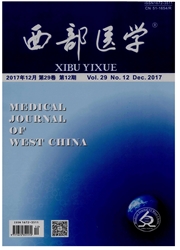

 中文摘要:
中文摘要:
目的 分析冠心病合并房颤患者的甲状腺激素水平的变化及其相关机制。方法选取冠心病患者150例,其中单纯冠心病患者80例(CAHD组),冠心病合并房颤者70例(CAHD+AF组),随机选取同期到院接受体检的健康者50例作为对照组。入院时,对两组患者进行血生化、颈动脉粥样硬化情况和甲状腺激素测定或评估。两组间计量资料比较采用t检验,计数资料比较采用χ^2检验。结果 与对照组比较,CAHD组和CAHD+AF组甲状腺激素水平、血脂、凝血功能及动脉粥样硬化厚度均明显升高。其中CAHD+AF和CAHD两组间FT4、TSH、血脂水平、凝血功和动脉粥样硬化程度均存在显著性差异(P〈0.05),而两组间TT3、TT4和FT3水平差异无统计学意义(P〉0.05)。结论 资料显示,FT4和TSH水平的下降可诱导血脂水平上升、凝血功能增强、动脉粥样硬化加重,容易诱发冠心病合并房颤的高危现象的发生。
 英文摘要:
英文摘要:
Objective To observe the changes of thyroid hormone level in patients with coronary heart disease complicated with atrial fibrillation and the related mechanism. Methods Of 150 patients with coronary heart disease, 80 patients were with coronary heart disease (CAHD group) and 70 patients with coronary heart disease complicated with atrial fibrillation (CAHD+AF group). 50 healthy volunteers in the same period were selected as control group. On admission, the test or assessment of blood biochemistry, carotid atherosclerosis and thyroid hormone were performed in two groups. Results The levels of thyroid hormones, blood lipids, coagulation function and the atherosclerosis thickness of CAHD+AF group and CAHD group were significantly increased when compared with the control group. The differences between CAHD+AF group and CAHD group of the level of FT4, TSH, blood lipid, blood coagulation function and degree of atherosclerosis were significant (P〈0.05). The differences between CAHD+AF group and CAHD group of the levels of TT3, TT4 and FT3 had no statistical significance (P〉0.05). Conclusion The decrease of FT4 and TSH levels can induce the increase of serum lipid levels, blood coagulation function and atherosclerosis, which can induce the high risk of coronary heart disease with atrial fibrillation.
 同期刊论文项目
同期刊论文项目
 同项目期刊论文
同项目期刊论文
 期刊信息
期刊信息
